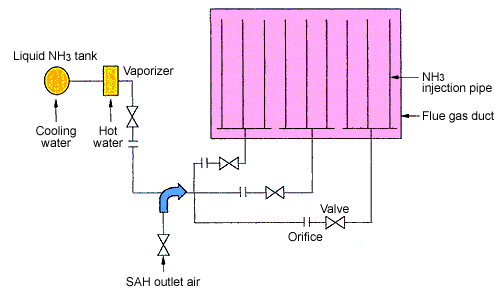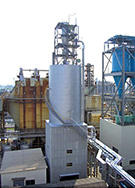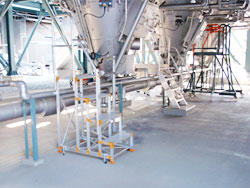Dry System (Ammonia-Injection System + Dry type Electrostatic Precipitator)
Ammonia-Injection System
Some of sulfur contained in boiler fuel is converted into SO3 gas in the furnace. When cooling, SO3 gas condenses and combines with water, forming fine particles referred to as "sulfuric acid mist (SO3 mist)," which is a severe cause of corrosion in equipment such as precipitators and ducts installed as the flue gas treatment system.
As a solution to that, Mitsubishi Heavy Industries was the first in the world to develop a system of ammonia injection into the flue gas, of which technology Mitsubishi Heavy Industries Power Environmental Solutions has taken over. In this system, diluted ammonia gas is injected into the flue gas duct to react it completely with SO3 so as to form stable solid particles, ammonium sulfate(NH4)2SO4, which are collected together with boiler dust with a dry type electrostatic precipitator. Ammonia gas is reacted with SO3 gas, which is at a high temperature before cooling and forming SO3, to render it harmless in terms of corrosion. Since the solid particles, which are reaction products, are removed from the flue gas with a dry type electrostatic precipitator, the problem of "bluish plume" discharge due to SO3 mist can be resolved as well.
This system is employed and well received at oil-fired power generation plants of most electric utilities in Japan.

Features
- Prevents low-temperature corrosion of ESP and blue plume.
- A gas mixer stabilizes SO3 concentration and temperature in flue gas duct to reduce excess NH3 injection.
- Uses nozzles that hardly clog. Nozzles can be purged with steam even if clogged.
- Appropriate controls of ammonia injection according to boiler load.
Considerations for Dry type Electrostatic Precipitator and Ash Handling System in the case of Ammonia Injection applied
In the ammonia injection system, solid particles of ammonium sulfate formed through a reaction of ammonia gas and SO3 gas are collected with a dry type electrostatic precipitator installed downstream. Thus, it is essential to combine ammonia injection with a dry type electrostatic precipitator to employ this system.
Ammonium sulfate (NH4)2SO4 formed by ammonium injection consists of very stable solid particles which can be relatively collected with ease by a dry type electrostatic precipitator. However, the entire SO3 gas is not completely converted into ammonium sulfate and, in some cases, part of it is converted into intermediate products consisting of substances called "ammonium bisulfate NH4HSO4." These intermediate products have high deliquescency and often stick to electrodes, grow on them, solidify and form lumps that hinder electric charging of the electrostatic precipitator, lower the fluidity of ash in the hopper, and hinder discharge of ash from the hopper to the ash handling system Especially in the case when fuel of extremely high sulfur content is used, the amount of ammonium sulfate produced may be large, and it is very likely to form undesirable intermediate products, possibly making it difficult to operate the plant stably and continuously for a long time.
Therefore, to employ an ammonia-injection system at a plant using high-sulfur fuel such as heavy oil, various considerations are required for the dry type electrostatic precipitator and ash handling system. The dry type electrostatic precipitators of Mitsubishi Heavy Industries Power Environmental Solutions are capable of maintaining reliable high-rapping performance in collecting difficult-to-handle particles. We can plan the most suitable rapping schedule and energization control by making best use of the know-how and extensive experience, in order to maintain stable energization condition.
Details of Dry type Electrostatic Precipitator
In order to smoothly discharge from a hopper ash of low fluidity caused by high-sulfur fuel such as heavy oil, we have commercialized a practical system that supplies pulse jet air onto the hopper interior wall synchronized with the ash handling system, contributing to stable and continuous long-term operation.
Owing to our extended experience with ash handling system and electrostatic precipitators, we plan and supply vacuum type ash handling system that contribute to the stable and continuous long-term operation of plants.


(Beneath hoppers of the electrostatic precipitator)
